How to Use a Mood Journal to Manage Your Emotions

From early cave paintings to the modern works of Toni Morrison, we can see how humans are natural storytellers. It’s how we make sense of our experiences, process our internal worlds, and connect with each other.
Journal writing is a powerful storytelling tool that we engage in with ourselves. When we arrange our experiences into a coherent narrative, our logical left hemisphere is able to integrate with our emotional right hemisphere, and we can experience a sense of wholeness.
So, while making the time and space to journal is a profound demonstration of self-care, it can also help increase your self-awareness, enhance your emotional intelligence, and uncover issues that, while kept buried inside, may impact your ability to thrive.
Journal prompts to process emotions
Through regular journal writing, you can acknowledge and process your thoughts and feelings so they don’t have such a strong grip over you. In fact, 15 minutes of journaling two times per week has been shown to potentially decrease symptoms of depression and anxiety and even boost your immune system.
There are several different ways to journal. Below are a couple of methods that have been explored in multiple studies and shown to be beneficial for your emotional and physical health.
Gratitude journaling: count your blessings to improve your mood
Research has found that keeping a gratitude journal can improve your mood and increase your happiness. It may also benefit your physical health.
In one study, people who regularly wrote five things that they were grateful for over 10 weeks, also spent more time exercising and had fewer physical complaints compared to people who wrote five complaints or simply five things that happened that day.
Try writing for around 10-15 minutes, 3 times per week. You can also use this method as a daily mood journal if that feels doable. To do it, choose a few things that you’re grateful for in each session and be as specific as possible.
Rather than writing, “I’m glad I got to spend time with my dad.” – write, “I’m glad that I got to spend time with my dad on Thursday afternoon when he met me for lunch. We were able to strengthen our bond and smooth over a nagging disagreement. I also felt more connected to my family and heritage.”

Put some thought into each item. Explore the various feelings and positive emotions that arise. Relish in the connections with people who bring you that sense of gratitude.
Don’t put your energy into creating a long list, but rather, focus on creating a rich and detailed list. Writing about one source of gratitude in-depth is more valuable than 20 different experiences of gratitude that aren’t fully felt or thought through.
To get you started, below are some gratitude journal prompts:
- You’ll always remember when your subway train left the station just as you entered, missing it by less than a minute. It’s incredibly frustrating! But what about all the times that you arrived to the platform just as the train doors opened for you? Think about some of the things that haven’t gone wrong that you’re thankful for, and write about those. Ask yourself, in what ways am I fortunate?
- Write about any unexpected positive surprises that have happened to you. How did it feel when it happened? What were the circumstances?
- Who are the people in your life that you are grateful for? Explore each person and write about specific attributes that contribute to the positivity in your life?
Digital journaling is a convenient way to establish a daily writing routine. Try our free app Coa, which allows you to write everything online using your phone or laptop from your Calmerry account.

Expressive writing: get unstuck by making space for your challenges
If you’re feeling stuck or stagnant, you might try writing about your hardships, failures, or challenges. This practice is called Expressive Writing and has been the subject of many studies over the past three decades.
It might be counterintuitive, but research tells us that writing about your negative emotions and experiences can actually have a positive impact on your well-being.
If you struggle with insomnia, it may be worth trying this before bed as it has been shown to help some people fall asleep more easily. If you’ve recently been fired, this practice may help you get a new job. And if you have a big test coming up, you might want to give it a try and see if the process improves your working memory.
Expressive Writing has also been shown to reduce harmful symptoms of certain mental health issues. For example, one small study found that people diagnosed with depression experienced a decrease in many of their symptoms in as quickly as five days after starting to journal. It’s also important to note that Expressive Writing has the potential to cause an increase in anxiety and distress immediately after journaling, even if it improves your mental health over the long run.
The key to Expressive Writing is to free flow about any emotional struggle(s) you’re experiencing. Leave a few minutes at the end to brainstorm ways to cope. If possible, don’t lift your pen from the paper, and don’t think too hard. Just write and let what comes, come. Remember, you don’t have to show this to anybody else or even re-read it yourself.
If you get writer’s block, think of yourself as an explorer. Go down any avenue or alleyway in your mind and see what’s there. Explore potential connections between your childhood experiences, parents, family, relationships, and current emotional challenges. Or if something’s been bothering you this week, write about that.

Even if it seems small and petty, if you’re struggling with something, it’s worth writing about.
Some Expressive Writing journal prompts include:
- Reflect on how emotions were dealt with in your family as a child. What do you like and/or dislike about this? Which patterns in your life has this contributed to? How would you like to continue to update these longstanding ways of being?
- Write about something you’re struggling with–the first thing that comes to mind. Then read it over and write about the obstacles and hurdles that contribute to this particular struggle.
- Choose a word like “sad,” “overwhelmed,” “stress,” “uncertainty,” or “anger” and free-write anything that comes to mind as you think about that word. You can start by writing other words that surface as you hold your prompt word in mind. And also explore scenarios, experiences, and anything else that links to that word for you.
An important caveat about Expressive Writing is that it is not meant to process ongoing or recent trauma and is not recommended for these issues.
Experiment and see what resonates with you
There’s no one right way to journal. Try the type that you’re drawn to, mix pieces of each together, or switch back and forth.
In addition, know that you do not have to keep a daily mood journal to experience the benefits. Sometimes weekly, or a few times a week might even be more powerful if you are able to do it consistently.
Go with what works for you. What’s most important is that you’re comfortable enough to fit journal writing into your regular routine.
Journal writing can support your progress in therapy
While journal writing can support you in knowing your emotions, rather than burying them, a therapist can function as a container to hold the experience with you.
If you’ve been harboring shame, fear, and pain, it’s likely impacting your physical and emotional health, no matter how much you’ve tried to stuff them down, lock them up, and throw away the key. Secrets have a way of creating a life of their own, and you remove their power when you share them. First, with yourself through your journaling. And when you’re comfortable, also with your online therapist.
online therapy
live video session



